Guide to UAS operations in Sweden
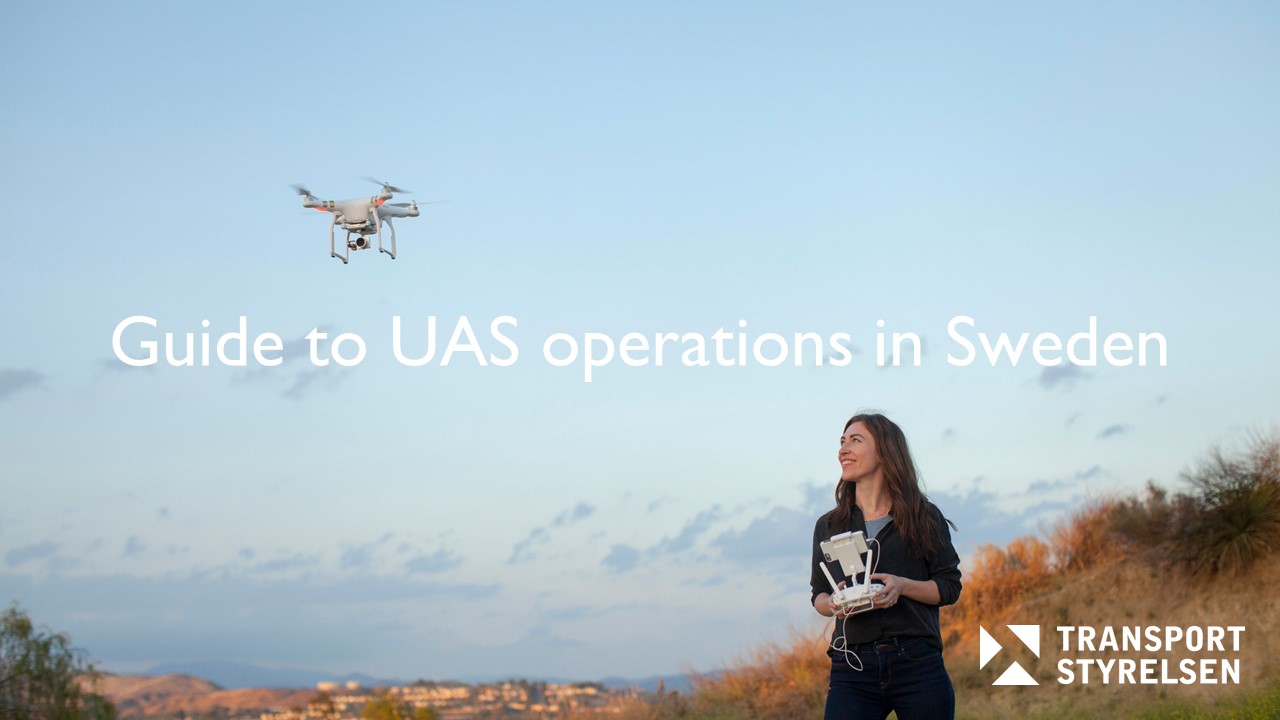
Are you planning on visiting Sweden and bringing your drone?
Welcome to your guide to safe UAS operations in Sweden!
Most UAS operations require UAS operator registration and remote pilot certificate of competency. Here is your guide to the applicable rules and regulations regarding safe UAS operations in Sweden.
Where are you planning on using your UAS?
In urban areas such as densely populated cities, drones may be used with extreme caution. It is never allowed to fly over assemblies of people, however a C0 (and C1 drone) may be flown over uninvolved people if it cannot be avoided. Before starting the UAS operation, the remote pilot should assess the area and should reasonably expect that no uninvolved person will be overflown.
| Suitable C-classes | C0 |
| Subcategory | A1<250g |
| Maximum altitude | 120m AGL or less |
| Flying over uninvolved people | C0 - should be avoided |
Implementing regulation (EU) 2019/947
AMC1 UAS.OPEN.020(1) and (2) UAS operations in subcategory A1
- For UAS in class C1, before starting the UAS operation, the remote pilot should assess the area and should reasonably expect that no uninvolved person will be overflown. This evaluation should be made taking into account the configuration of the site of operation (e.g. the existence of roads, streets, pedestrian or bicycle paths), and the possibility to secure the site and the time of the day. In case of an unexpected overflight, the remote pilot should reduce as much as possible the duration of the overflight, for example, by flying the UAS in such a way that the distance between the UA and the uninvolved people increases, or by positioning the UAS over a place where there are no uninvolved people.
- It is accepted that UAS in class C0 or privately built UAS with MTOMs less than 250 g may fly over uninvolved people; however, this should be avoided whenever possible, and where it is unavoidable, extreme caution should be used.
In suburban areas, for example residential areas, uninvolved people can most likely be avoided. However, it can be a challenge to maintain at least 150m to from residential, commercial, industrial or recreational areas. Therefore the most suitable drones to use would be C0 and C1, or C2 in low speed mode. Remember to apply the 1:1 rule for C2 drones.
Please mind the noise in residential areas.
| Suitable C-classes | C0, C1, (C2 in low speed mode) |
| Subcategory | A1, (A2) |
| Maximum altitude | 120m AGL or less (Apply 1:1 rule for C2) |
| Flying over uninvolved people | C0, C1 - should be avoided C2 - not allowed, see 1:1 rule |
Implementing regulation (EU) 2019/947,
AMC1 UAS.OPEN.020(1) and (2) UAS operations in subcategory A1:
- For UAS in class C1, before starting the UAS operation, the remote pilot should assess the area and should reasonably expect that no uninvolved person will be overflown. This evaluation should be made taking into account the configuration of the site of operation (e.g. the existence of roads, streets, pedestrian or bicycle paths), and the possibility to secure the site and the time of the day. In case of an unexpected overflight, the remote pilot should reduce as much as possible the duration of the overflight, for example, by flying the UAS in such a way that the distance between the UA and the uninvolved people increases, or by positioning the UAS over
a place where there are no uninvolved people. - It is accepted that UAS in class C0 or privately built UAS with MTOMs less than 250 g may fly over uninvolved people; however, this should be avoided whenever possible, and where it is unavoidable, extreme caution should be used.
In sparsely populated areas with no residential, commercial, industrial or recreational areas close by (150m or more), the usage of UAS is less restricted. Always remember to maintain an altitude of 120m AGL or less and keep required distance to uninvolved persons.
| Suitable C-classes | C0-C4 or UAS with no C-class |
| Subcategory | A1, A2, A3 |
| Maximum altitude | 120m AGL or less (1:1 rule applies for C2-C4) |
| Flying over uninvolved people | C0, C1 - should be avoided C2, C3, C4 - not allowed, see 1:1 rule |
It is never allowed to fly over assemblies of people, however a C0 drone may be flown over uninvolved people if it cannot be avoided.
| Suitable C-classes | C0, C1, (C2 in low speed mode) |
| Subcategory | A1, (A2) |
| Maximum altitude | 120m AGL or less (Apply 1:1 rule for C2) |
| Flying over uninvolved people | C0, C1 - should be avoided C2 - not allowed, see 1:1 rule |
Implementing regulation (EU) 2019/947
AMC1 UAS.OPEN.020(1) and (2) UAS operations in subcategory A1
- For UAS in class C1, before starting the UAS operation, the remote pilot should assess the area and should reasonably expect that no uninvolved person will be overflown. This evaluation should be made taking into account the configuration of the site of operation (e.g. the existence of roads, streets, pedestrian or bicycle paths), and the possibility to secure the site and the time of the day. In case of an unexpected overflight, the remote pilot should reduce as much as possible the duration of the overflight, for example, by flying the UAS in such a way that the distance between the UA and the uninvolved people increases, or by positioning the UAS over
a place where there are no uninvolved people. - It is accepted that UAS in class C0 or privately built UAS with MTOMs less than 250 g may fly over uninvolved people; however, this should be avoided whenever possible, and where it is unavoidable, extreme caution should be used.
Definition of uninvolved persons:
Persons who are not participating in the UAS operation or who are not aware of the instructions and safety precautions given by the UAS operator.
You can find a complete definition in Cover Regulation in (EU) 2019/947, GM1 Article 2(18) Definitions.
Definition of assemblies of people
(Cover regulation in (EU) 2019/947, GM1 Article 2(3) Definitions)
Assemblies of people have been defined by an objective criterion related to the possibility for an individual to move around in order to limit the consequences of an out-of-control UA. It was indeed difficult to propose a number of people above which this group of people would turn into an assembly of people: numbers were indeed proposed, but they showed quite a large variation. Qualitative examples of assemblies of people are:
- sport, cultural, religious or political events;
- beaches or parks on a sunny day;
- commercial streets during the opening hours of the shops; and
- ski resorts/tracks/lanes.
It is never allowed to fly over assemblies of people, however a C0 drone may be flown over uninvolved people if it cannot be avoided.
| Suitable C-classes | C0 or no C-class<250g |
| Subcategory | A1<250g |
| Maximum altitude | 120m AGL or less |
| Flying over uninvolved people | C0 - should be avoided when possible |
Implementing regulation (EU) 2019/947
AMC1 UAS.OPEN.020(1) and (2) UAS operations in subcategory A1
- For UAS in class C1, before starting the UAS operation, the remote pilot should assess the area and should reasonably expect that no uninvolved person will be overflown. This evaluation should be made taking into account the configuration of the site of operation (e.g. the existence of roads, streets, pedestrian or bicycle paths), and the possibility to secure the site and the time of the day. In case of an unexpected overflight, the remote pilot should reduce as much as possible the duration of the overflight, for example, by flying the UAS in such a way that the distance between the UA and the uninvolved people increases, or by positioning the UAS over
a place where there are no uninvolved people. - It is accepted that UAS in class C0 or privately built UAS with MTOMs less than 250 g may fly over uninvolved people; however, this should be avoided whenever possible, and where it is unavoidable, extreme caution should be used.
Definition of uninvolved persons:
Persons who are not participating in the UAS operation or who are not aware of the instructions and safety precautions given by the UAS operator.
You can find a complete definition in Cover Regulation to (EU) 2019/947, GM1 Article 2(18) Definitions.
Flying over highways
| C-class | What is allowed? | Condition(s) |
| C0, C1 or no C-class<250g | - Crossing the road - No hovering above the road - 1:1 rule* |
- Minimum 20m AGL or above obstacles (street lights etc.) - Always maintain VLOS - No moving vehicles on the road |
| C2 | - Crossing the road - No hovering above the road - 1:1 rule* |
- Minimum 20m AGL or above obstacles (street lights etc.) - Always maintain VLOS - No moving vehicles on the road |
| C3, C4 | - Crossing or hovering not allowed - 1:1 rule* |
|
| No C-class or legacy drone (MTOM>250g) | - Crossing or hovering not allowed - 1:1 rule* |
Other roads
| C-class | What is allowed? | Condition(s) |
| C0-C4 | - Crossing the road - No hovering above the road - 1:1 rule* |
- Minimum 20m AGL or above obstacles (street lights etc.) - Always maintain VLOS - No moving vehicles on the road |
| No C-class or legacy drone (MTOM>250g) | - Crossing the road - No hovering above the road - 1:1 rule* |
- Minimum 20m AGL or above obstacles (street lights etc.) - Always maintain VLOS - No moving vehicles on the road |
*1:1 rule applies when hovering close to a road or flying alongside.
Please remember to also maintain the required distances according to A1, A2 and A3.
Source: EASA | Guidelines on operations in the open and specific category (PDF)
When flying an unmanned aircraft within a horizontal distance of 50 metres from an artificial obstacle taller than 105 metres, the maximum height of the UAS operation may be increased up to 15 metres above the height of the obstacle at the request of the entity responsible for the obstacle.

When operating an UAS in hilly terrain, it may be operated 120m or above the starting point provided is does not exceed 120m above ground level.
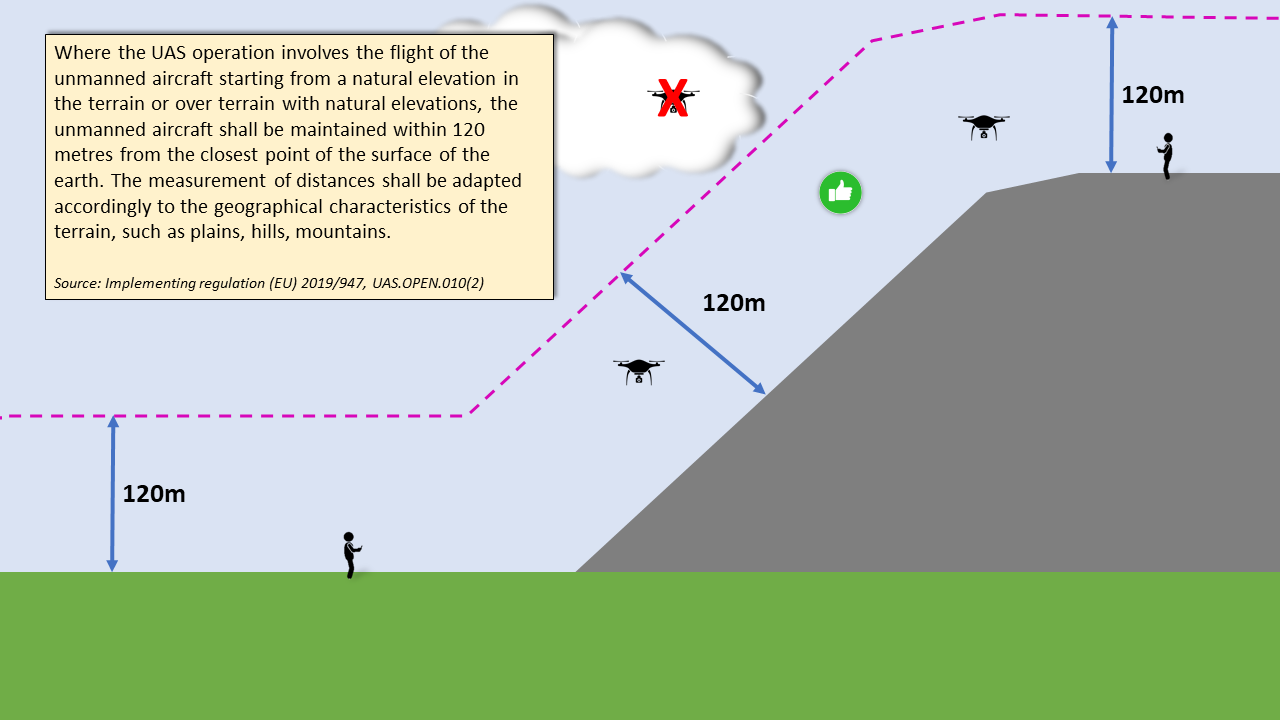
Most larger airports in Sweden is surrounded by a CTR. Within the CTR, an UAS may be flown to a maximum altitude of 50m AGL, or 10m AGL in a military airport CTR. Closer than 5km to any runway, you need permission from air traffic control regardless of the altitude. Please remember that the surroundings of the airport must considered. If the area is densely populated you shall apply applicable safety measures etc.
| Suitable C-classes | C0-C4 or UAS with no C-class |
| Subcategory | A1, A2, A3 |
| Maximum altitude within 5km from a runway (CTR) | Permission from air traffic control required to fly within 5km of a runway |
| Maximum altitude more than 5km from a runway (CTR) | 50m AGL (10m for military airports) |
| Flying over uninvolved people | C0, C1 - should be avoided C2, C3, C4 - not allowed, see 1:1 rule |
In the vicinity of a heliport
Within 1000m of a heliport, an UAS may only be flown after coordinating with the heliport.
Always visit the dronechart prior to flying!
Contact information to all Swedish Air Traffic Control services can be found in the Swedish eAIP GEN 3.3.
A restricted area may be permanently or temporary established. Either to protect something in the area, for example nuclear power plant, or to protect other air traffic outside of the area from the operations in the area.
To fly in a restricted area, you need permission.
Go to information about permission to fly in restricted area.
Always visit the Dronechart prior to flying.
A danger area is established to protect and warn other air traffic of high risk activities in an area. For example UAS operations in BVLOS, military activity, rock blasting at a construction site etc.
Flying in danger areas is not prohibited, however, it should be avoided unless the operator can guarantee it can be performed without increased risk due to the ongoing activity.
Dangers areas are notified via AIP SUP and NOTAM. They are also usually published on the Dronechart.
AIP SUP and NOTAM can be accessed via AroWeb. AIP SUP is found in the eAIP.
| Suitable C-classes | C0-C2, no C-class MTOM<250g |
| Subcategory | A1, A2 |
| Maximum altitude | 120m AGL or less (Apply 1:1 rule for C2) |
| Flying over uninvolved people | C0, C1 - should be avoided C2 - not allowed, see 1:1 rule |
When operating an UAS within 150m from a recreational area, C3, C4 and UAS with no class with a MTOM above 250g is not allowed according to required distances in A3 (UAS.OPEN.040).
When using C0-C2 or UAS with no c-class lighter than 250g, maintain required distances according to A1 and A2.
There is no definition of a recreational area in the regulation. A recreational area may vary with season depending on the number of persons visiting the area. For example a beach during summer. An assessment of the area is required by the operator prior to each flight.
National Park is the strongest protection an area of valuable nature can be granted. It is only granted to the finest and most valuable areas in the Swedish landscape. The protection is needed for both nature’s own sake and for human sake. By protecting valuable nature from being destroyed, or from disappearing, we can preserve our common natural and cultural heritage.
National parks are usually restriced airspace, you need permission to operate an UAS in a National Park. More information is available on the Dronechart.
Go to information about permission to fly in restricted area.
Takeoff and landing within a nature reserve may be prohibited. The County Administrative Board (Länsstyrelsen) is usually responsible for managing protected nature. You can read more on their website, there is also a map of protected nature available.
Protected nature | Länsstyrelsen (lansstyrelsen.se)
Always be extra careful and respect the wildlife and the nature.
If you are uncertain whether you are allowed to operate an UAS or not in the area, please contact Länsstyrelsen.
Always visit the Dronechart prior to flying.
If flying is allowed, please remember to maintain required distances according to A1, A2 and A3.
When operating a drone using goggles (FPV), you need an observer. The observer must be in direct contact with the remote pilot, using phones or other communication devices is not allowed.
Remember to maintain required distances according to A1, A2 and A3.
Impl. Regulation (EU) 2019/947, Annex part A:
GM1 UAS.OPEN.060(4) Responsibilities of the remote pilot
The remote pilot may be assisted by a UA observer helping them to keep the UA away from obstacles. The UA observer must be situated alongside the remote pilot in order to provide warnings to the remote pilot by supporting them in maintaining the required separation between the UA and any obstacle, including other air traffic.
UA observers may also be used when the remote pilot conducts UAS operations in first-person view (FPV), which is a method used to control the UA with the aid of a visual system connected to the camera of the UA. In any case, including during FPV operations, the remote pilot is still responsible for the safety of the flight.
As the UA observer is situated alongside the remote pilot and they must not use aided vision (e.g. binoculars), their purpose is not to extend the range of the UA beyond the VLOS distance from the remote pilot. Exceptions are emergency situations, for instance, if the pilot must perform an emergency landing far from the pilot’s position, and binoculars can assist the pilot in safely performing such a landing.
When operating at night or in poor visibility, ensure that a green flashing light on the unmanned aircraft is activated.
Definition of night
The hours between the end of evening civil twilight and the beginning of morning civil twilight. Civil twilight ends in the evening when the centre of the sun’s disc is 6 degrees below the horizon and begins in the morning when the centre of the sun’s disc is 6 degrees below the horizon.
(Implementing regulation (EU) 923/2012 - SERA, article 2(97))
Privately built UAS may operate according to:
- A1 if MTOM less than 250g and speed less than 19m/s
- A3 if MTOM 250g or more
UAS with MTOM less than 250g
| Subcategory | A1<250g |
| MTOM (Weight) | Less than 250g |
| Minimum distance requirements | - It is accepted that UAS with MTOM less than 250g may fly over uninvolved people, however it should be avoided - Maximum 120m AGL - Forbidden to fly over assemblies of people |
| Competency requirements | - Read the user manual (if applicable) |
| Operator-ID | - No, unless UAS is equipped with a sensor able to capture personal data (eg. a camera) |
UAS with MTOM 250g or more
| Subcategory | A3 |
| MTOM (Weight) | Less than 25kg |
| Minimum distance requirements |
- Minimum 150m from residential, commercial, industrial or recreational areas |
| Competency requirements |
- Read the user manual |
| Operator-ID | - Required |
Registration of UAS operator
An operator-ID is required if operating an UAS:
- with a MTOM of 250 g or more
- equipped with a sensor able to capture personal data (eg. a camera)
The operator ID shall be displayed on the UAS in a way that the characters are readable at least when the UAS is on the ground, without using other devices than eyeglasses or corrective lenses. A QR code may be used.
The full string, which consists of the UAS operator registration number and the three (3) randomly generated alphanumerics, shall be uploaded into the electronic identification system, if available.
An operator-ID issued in any EU/EASA member state is valid in the entire European Union, including Sweden.
Read more about Registration of UAS operator
Remote pilot certificate of competency
A remote pilot certificate of competency, or "drone license", is required to operate any UAS with a MTOM of 250g or more.
To apply for a drone license, contact dronarutbildning@transportstyrelsen.se
A drone license issued in any EU/EASA member state is valid in the entire European Union, including Sweden.
Dronechart
The dronechart is an interactive map designed to aid UAS operators. The map contains, among other things: lower airspaces, heliports, danger areas, restricted areas, NOTAMs and AIP SUP.
Some information may not be available, the primary source of information is AroWeb provided by LFV.
Always visit the Dronechart prior to flying.
AIP SUP
AIP SUP is normally used to publish temporary changes to AIP that lasts longer than three months, or changes that contains large amount of text and/or graphic. AIP SUP for Sweden can be found on LFV AroWeb.
Hover over AIS in the top menu, press "eAIP", choose latest version of "effective date" and navigate to SUPs in the top menu.
NOTAM
NOTAM is a service that continuously publishes aeronautical information which either changes before the AIP has been updated, or when it concerns information of a temporary nature, such as a closed runway at an airport.
AIP SUP for Sweden can be found on LFV AroWeb. Hover over AIS in the top menu and choose which NOTAM series you want to read.
NOTAM and AIP SUP are usually published on the Dronechart.
Required safe distances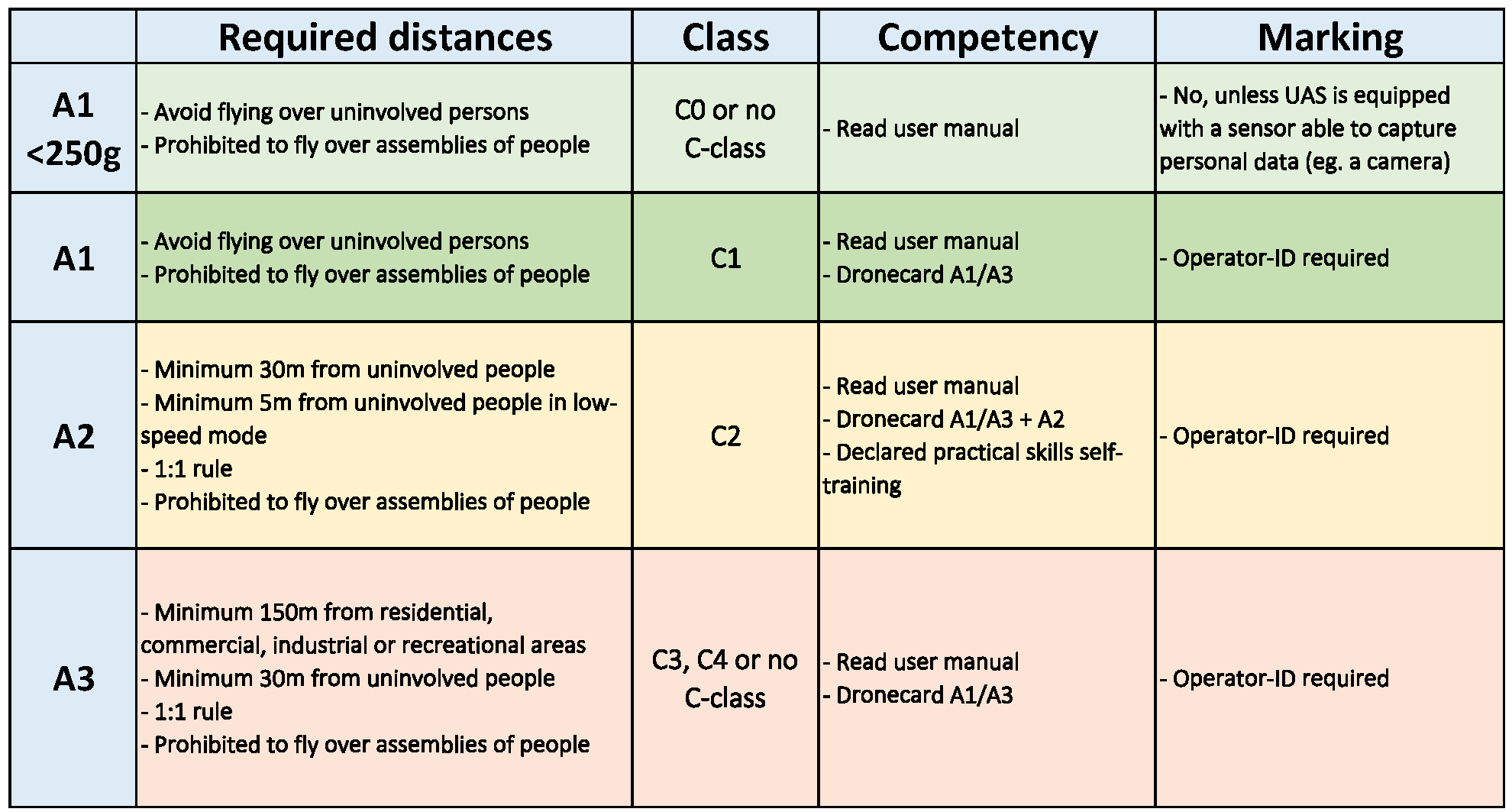
Download table as an image (PNG)
1:1 rule
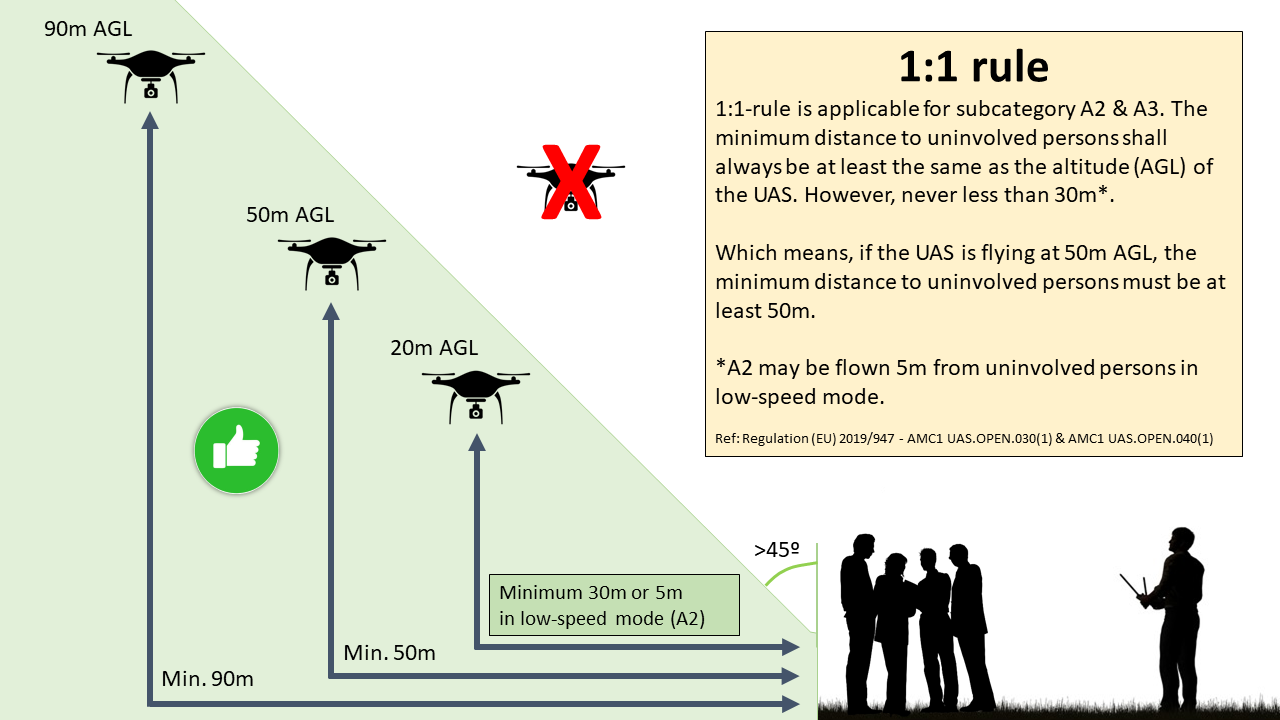
What is applicable for each class marking?

| Subcategory | A1<250g |
| MTOM (Weight) | Less than 250g |
| Minimum distance requirements | - It is accepted that UAS in class C0 may fly over uninvolved people; however, this should be avoided whenever possible, and where it is unavoidable, extreme caution should be used. - Maximum 120m AGL - Prohibited to fly over assemblies of people |
| Competency requirements | - Read the user manual |
| Operator-ID | - No, unless UAS is equipped with a sensor able to capture personal data (eg. a camera) |
AMC1 UAS.OPEN.020 (1) and (2) UAS operations in subcategory A1
It is accepted that UAS in class C0 or privately built UAS with MTOMs less than 250 g may fly over uninvolved people; however, this should be avoided whenever possible, and where it is unavoidable, extreme caution should be used.

| Subcategory | A1 |
| MTOM (Weight) | Less than 900g |
| Minimum distance requirements | - Flying over uninvolved people should be avoided - Maximum 120m AGL - Prohibited to fly over assemblies of people |
| Competency requirements | - Read the user manual - Drone license |
| Operator-ID | - Required |
AMC1 UAS.OPEN.020 (1) and (2) UAS operations in subcategory A1
For UAS in class C1, before starting the UAS operation, the remote pilot should assess the area and should reasonably expect that no uninvolved person will be overflown. This evaluation should be made taking into account the configuration of the site of operation (e.g. the existence of roads, streets, pedestrian or bicycle paths), and the possibility to secure the site and the time of the day.
In case of an unexpected overflight, the remote pilot should reduce as much as possible the duration of the overflight, for example, by flying the UAS in such a way that the distance between the UA and the uninvolved people increases, or by positioning the UAS over a place where there are no uninvolved people.

| Subcategory | A2 |
| MTOM (Weight) | Less than 4kg |
| Minimum distance requirements |
- Minimum 30m from uninvolved people |
| Competency requirements |
- Read the user manual |
| Operator-ID | - Required |
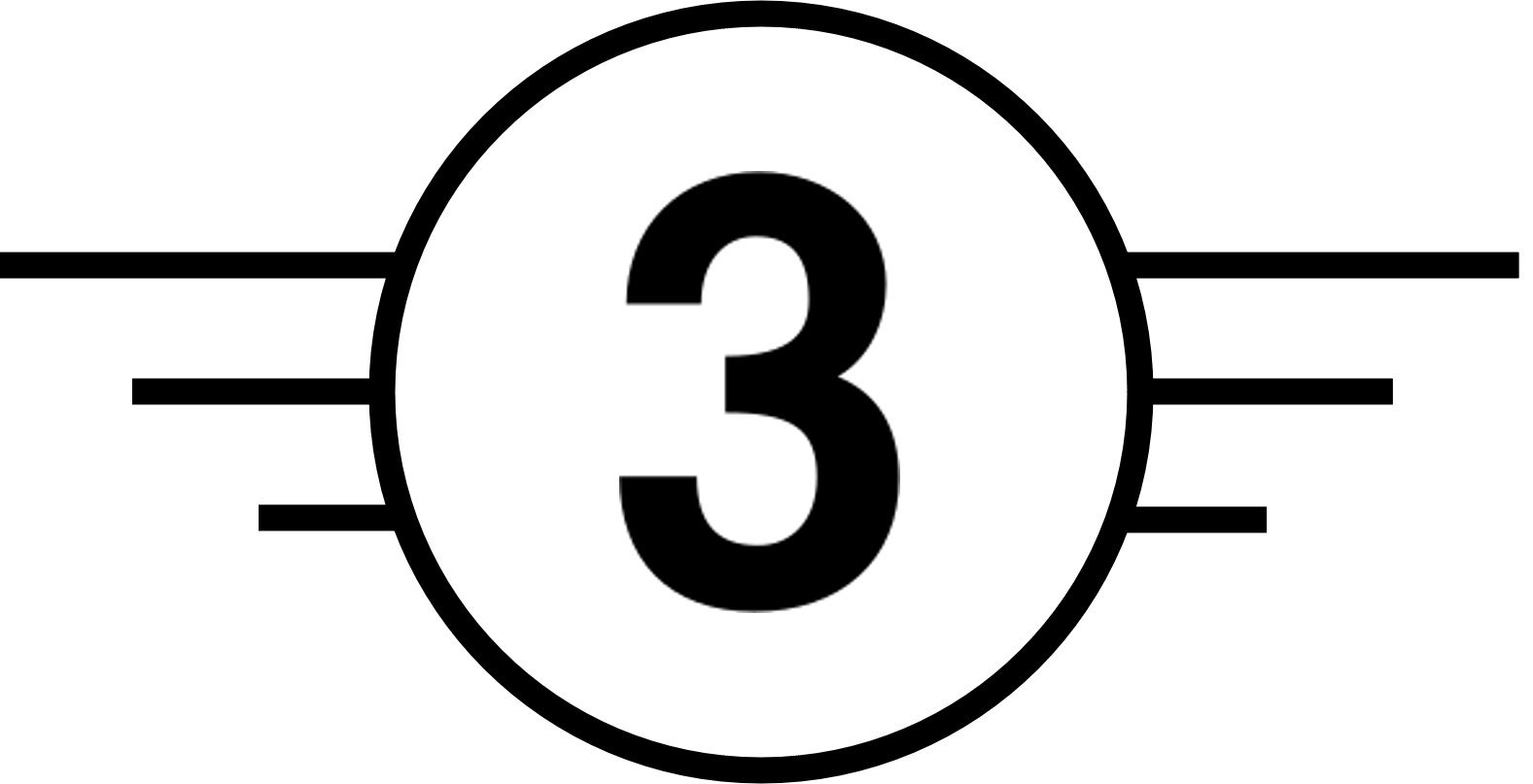
| Subcategory | A3 |
| MTOM (Weight) | Less than 25kg |
| Minimum distance requirements |
- Minimum 150m from residential, commercial, industrial or recreational areas |
| Competency requirements |
- Read the user manual |
| Operator-ID | - Required |
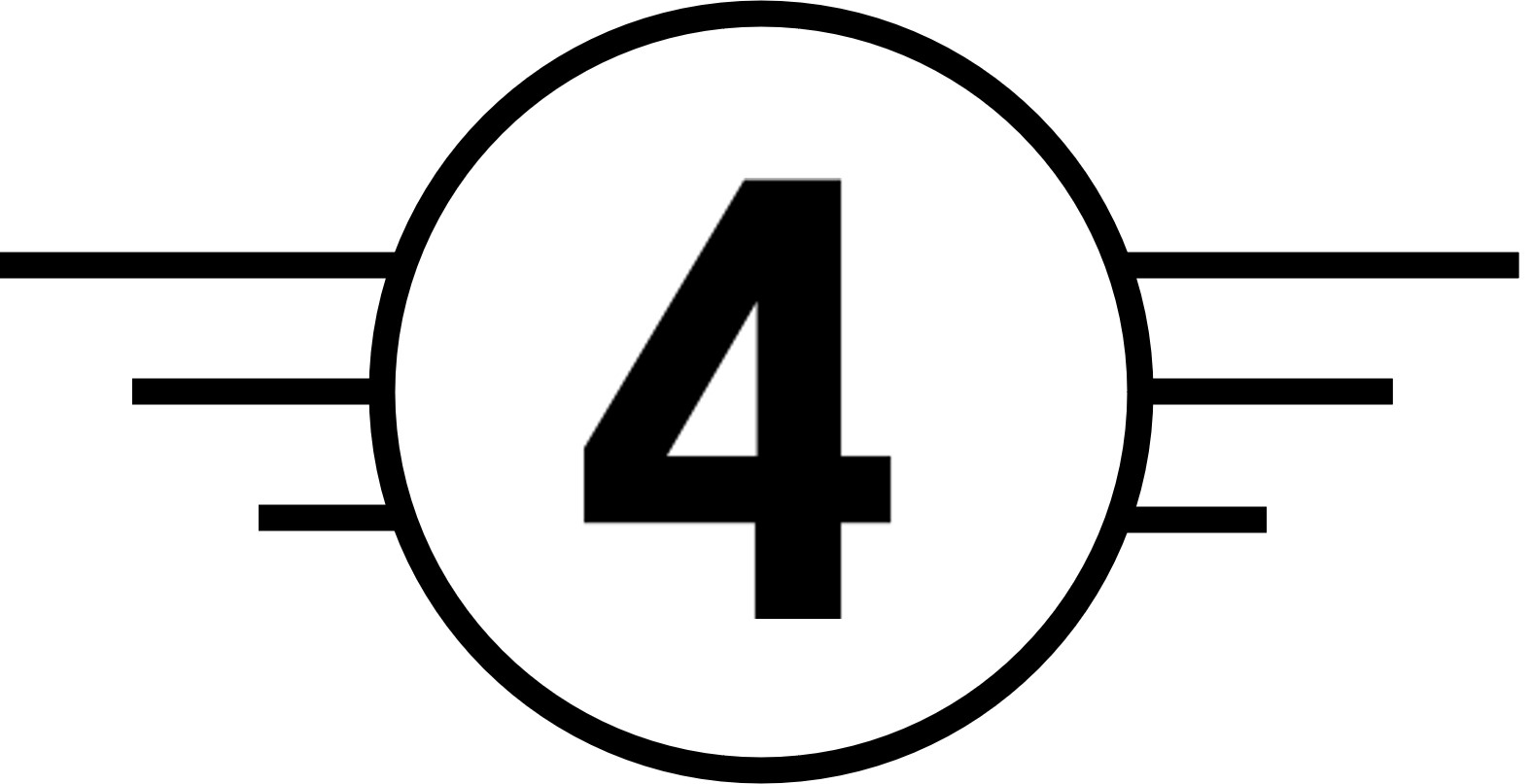
| Subcategory | A3 |
| MTOM (Weight) | Less than 25kg |
| Minimum distance requirements |
- Minimum 150m from residential, commercial, industrial or recreational areas |
| Competency requirements |
- Read the user manual |
| Operator-ID | - Required |
UAS released on the market prior to January 1st 2024 with no class marking are only allowed to fly according to:
A1 if MTOM less than 250g
A3 if MTOM 250g or more
UAS released on the market after January 1st 2024 are only allowed to be used with permission from the Swedish Transport Agency unless used at designated model flying area.
UAS with MTOM less than 250g
| Subcategory | A1<250g |
| MTOM (Weight) | Less than 250g |
| Minimum distance requirements | - It is accepted that UAS with MTOM less than 250g may fly over uninvolved people, however it should be avoided - Maximum 120m AGL - Prohibited to fly over assemblies of people |
| Competency requirements | - Read the user manual (if applicable) |
| Operator-ID | - No, unless UAS is equipped with a sensor able to capture personal data (eg. a camera) |
UAS with MTOM 250g or more
| Subcategory | A3 |
| MTOM (Weight) | Less than 25kg |
| Minimum distance requirements |
- Minimum 150m from residential, commercial, industrial or recreational areas |
| Competency requirements |
- Read the user manual |
| Operator-ID | - Required |
Did you buy your drone prior to January 1st 2024?
UAS placed on the market prior to January 1st 2024 with no C-class, may continue to be operated:
- In subcategory A1, provided that the UAS has a maximum take-off mass of less than 250 g, including its payload;
- In subcategory A3, provided that the UAS has a maximum take-off mass of less than 25 kg, including its fuel and payload.
UAS placed on the market after January 1st 2024 with no C-class is allowed to be operated with permission in category specific or within a model flying club.
Dissemination permit
Footage over land
If you have photographed or filmed from aircraft such as drones, planes, helicopters or hot air balloons and want to share, publish or sell your photos, you must apply for a dissemination permit. The permit requirement applies to photographs and similar registration of data. These may include aerial photos, videos, laser data, altitude data etc.
Read more about dissemination permit over land | Lantmäteriet
Footage over sea
If you have collected data, photographed or filmed information depicting conditions on or under the seabed that you want to share, publish or sell, you need to apply for dissemination authorisation. The authorisation requirement also applies to compilations of geographical information relating to the seabed.
Before disseminating surveys, photographs and other material depicting conditions on or under the seabed within Swedish territory, you need to apply for a dissemination permit from the Swedish Maritime Administration (SMA).
Read more about dissemination permit over sea | SMA
Insurance
For UAS operations with a MTOM less than 20kg used in leisure-, display- or recreational flights, insurance is not required in accordance with regulation (EC) 785/2004.
Rules and regulations
EU-regulations
| EASA Easy Access Rules for UAS | Implementing regulation (EU) 2019/947 and 2019/945 |
| Insurance requirements | Regulation (EC) 785/2004 |
